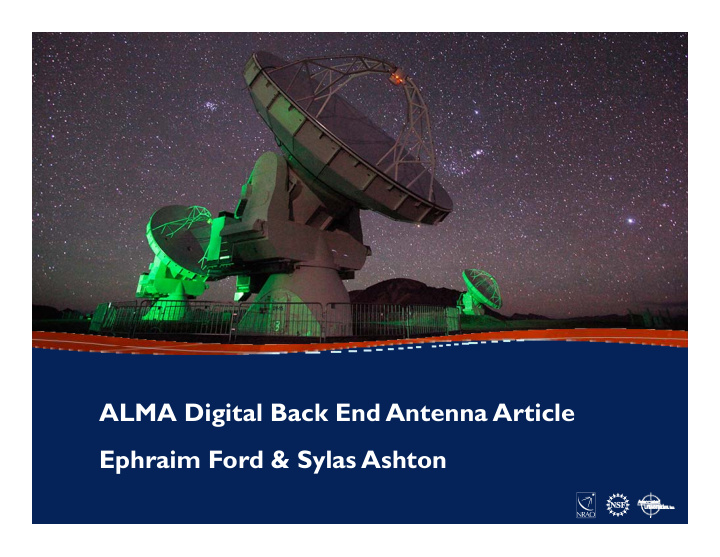



ALMA Digital Back End Antenna Article Ephraim Ford & Sylas Ashton ALMA Future Science Development Program Workshop 1
Digital Back End Antenna Article Design Study Overview • Intent is to investigate potential solutions for increasing the sampled IF bandwidth, aligning with 2030 Pathways . • An initial study of digitally downconverting the entire current 8GHz per IF is proposed. Can be broadened to 16 GHz/IF. • Result will be a better understanding of technical risks and issues and the path towards a deployable all-digital Back End for ALMA, interfacing with an upgraded correlator. ALMA Future Science Development Program Workshop 2
Collaborators N AME I NSTITUTION E MAIL Ephraim Ford NRAO eford@nrao.edu Sylas Ashton NRAO sashton@nrao.edu Doug Gerrard NRAO dgerrard@nrao.edu Chris Langley NRAO clangley@nrao.edu Mike Revnell NRAO mrevnell@nrao.edu Matt Luce NRAO mluce@nrao.edu Alan Erickson NRAO aerickso@nrao.edu Richard Lacasse NRAO rlacasse@nrao.edu Alejandro Saez JAO/NRAO asaez@nrao.edu Chris Carilli NRAO ccarilli@nrao.edu Luca Ricci Harvard ‐ Smithsonian Luca.ricci@cfa.harvard.edu ALMA Future Science Development Program Workshop 3
Current Back End Antenna Article As installed in Chile • 2 racks, populated with RF shielded modules, divided into RF and digital domains. • Converts the 4-12 GHz IFs (2 Pol) to 4 baseband channels. • Digitizes at 4 GS/s at 3 bits and delivers to correlator. ALMA Future Science Development Program Workshop 4
Study Goals • Goal is a design study for a digital Back End that fits within the current ALMA interfaces while allowing for future enhancements. • Study will lay a foundation for future work, leading to a deployable article on an antenna. • Deliverables: – Development assembly/platform (PCB with chosen design and hardware for study). – Firmware – Outcomes reports with board and ADC characterizations and recommendations for future work or proposals. ALMA Future Science Development Program Workshop 5
Design Areas of Focus • Approach two key risks: – Exercise current COTS digitizers to determine their suitability. • Can they provide the high-speed sampling at 24GHz as specified by the manufacturers? – At a wider IF, development of DSP throughput rates higher than the Field Programmable Gate Array (FPGA) digital clock. • Hittite AD5831 3-bit 26GS/s digitizers likely to be used, clocked at 24 GHz. • Some design investigation has begun, as described in the proposal. ALMA Future Science Development Program Workshop 6
Potential Design Block Diagram Digital Backend Total Power Total ADC Power 0 ‐ 31.5dB SPF+ 10GBs Detector Variable USB P0 +48dB ADC fiber TX Attenuator SPF+ 10GBs fiber TX TPD SPF+ 10GBs fiber TX SPF+ 10GBs fiber TX LSB P0 +48dB Var. Att. ADC SPF+ 10GBs fiber TX To Optical SPF+ 10GBs fiber TX FPGAs TPD Correlator Mux SPF+ 10GBs fiber TX USB P1 SPF+ 10GBs fiber TX +48dB Var. Att. ADC SPF+ 10GBs fiber TX SPF+ 10GBs fiber TX TPD SPF+ 10GBs fiber TX LSB P1 +48dB Var. Att. ADC SPF+ 10GBs fiber TX 24GHz x4 300MHz x4 250MHz x6 x2 DDS 4GHz DGCK 125MHz TE LORR ALMA Future Science Development Program Workshop 7
Next Steps • Kickoff meeting in October • Proof of Concept design & review (3 months) • Fabrication of hardware & design of firmware (3 months) • On-hardware FW development & ADC analysis (4 months) • Project closeout (1 month) • Project end of study in September 2017. • Comments and feedback are welcome now. ALMA Future Science Development Program Workshop 8
Simplified Current Back End Analog Rack ALMA Future Science Development Program Workshop 9
Simplified Current Back End Digital Rack ALMA Future Science Development Program Workshop 10
www.nrao.edu science.nrao.edu public.nrao.edu The National Radio Astronomy Observatory is a facility of the National Science Foundation operated under cooperative agreement by Associated Universities, Inc. ALMA Future Science Development Program Workshop 11
Recommend
More recommend